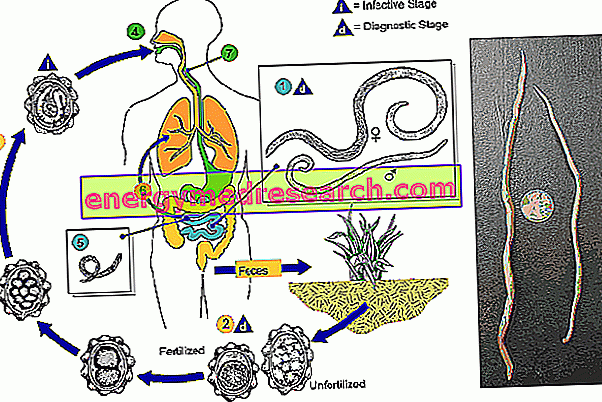What is that
Ascaris lumbricoides is a parasitic worm capable of infesting many mammals (pig, horse, dog, cat etc.), including humans.
The average size of an adult female is about 30 cm by 5 mm, while the smaller male measures "only" 20 cm by 4 mm.

Transmission and Contagion
Imagining a few dozen adult Ascaris intent on wandering in our intestines is certainly not an exciting thing, especially for those who, living in poor sanitation, run a serious risk that the horrifying eventuality materializes.
The infestation is contracted by ingestion of contaminated food (above all fruit and vegetables) with the mature eggs of the worm, which can reach the small intestine even after the introduction into the mouth of soil-smeared hands.
Biological cycle
Arrived in the upper part of the small intestine, the eggs hatch, allowing the larvae to escape and take the bloodstream after having perforated the intestinal wall.
Carried by the blood, the Ascaris larvae reach the right heart which, contracting, pushes them little by little to the pulmonary capillaries, where they settle, starting their own development cycle. After about 10 days, the larvae, further developed, go up the respiratory tree until they reach the backbore, where they are partly swallowed and partly eliminated from the outside, through sputum, sneezing and coughing.
Once again in the small intestine, the ingested larvae complete their maturation becoming adult specimens within two or three months. Each female, after having mated with the male, lays about 200, 000 eggs a day, which are then emitted with the faeces and dispersed in the soil, where in suitable climatic conditions (moist, aerated, temperate but not directly exposed to the sun), they can survive long before being ingested through water or vegetables. During this period, the larvae develop inside the eggs which, over a period of time ranging from 18 days to several weeks, undergo two mutations before reaching the human infestation stage.

Prevention
The prevention of ascoliosis (it is so called the disease caused by the infestation of a Ascaris) is based on the respect of the elementary hygienic rules, often disregarded in the countries of the third world: it is necessary to wash and cook the vegetables carefully before consumption (the heat kills Ascaris eggs), but also reduce environmental contamination with feces and their use as a fertilizer.
Symptoms
Sometimes the presence of a limited number of specimens does not determine specific symptoms and represents a random finding. More frequently the infestation with Ascaris lumbricoides causes gastrointestinal suffering (pain, nausea, vomiting and diarrhea alternating with constipation).
Considering the size of the worm, it is possible that one or more specimens, moving inside the digestive tract, rise up to the liver, obstructing the biliary tract (through which the organ pours bile into the intestine). This can lead to the onset of violent pains, jaundice from stasis, calculi, hepatitis and acute cholecystitis; also possible appendicitis and intestinal obstructions.
At whatever level it occurs, the persistent obstruction gradually determines the necrosis of the affected tissue, resulting in organ perforation, a complication that is very dangerous for the survival of the individual. The young age and the state of malnutrition increase the risk of a poor prognosis.
In the early stages, when the larvae are localized in the respiratory tract, the disease is characterized by a coughing, not very productive, and frequent chest pain, which is exacerbated under coughing sometimes accompanied by the expulsion of bright red blood.
Diagnosis
The examination of the faeces, through which the presence of eggs is sought, constitutes the main diagnostic form. Radiological and endoscopic examinations are necessary if Ascaris is suspected in the duodenum and biliary tract. Sometimes the infestation is evidenced by the emission of worms with feces or vomit; sometimes they can also go up the digestive tract spontaneously and come out of the nose or mouth.
Treatment
The treatment of ascidianosis is based on antibiotic therapy which, when it does not produce immediate results, acts as a prelude to surgery.
The medications recommended by the World Health Organization for the treatment of ascariasis include: albendazole, mebendazole, levamisole and Pirantel Pamoate
The prognosis is poor only in the most serious cases, neglected and complicated by late diagnosis.



